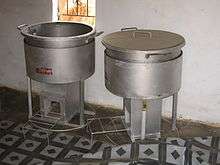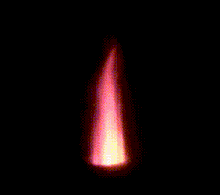Rocket stove
A rocket stove is an efficient and hot burning stove using small-diameter wood fuel.[1][2] Fuel is burned in a simple combustion chamber containing an insulated vertical chimney, which ensures almost complete combustion prior to the flames reaching the cooking surface. Rocket stove designs are most often used for portable stoves for cooking but the design is also used for large fixed stoves in institutions, and to make rocket mass heaters for heating.[3]





In field tests in India, rocket stoves used 18 to 35 percent less fuel compared to the traditional stoves and reduced fuel used 39-47 percent compared to the simple traditional open three-stone fire, as well as a large reduction in emissions.
History
A precursor to the rocket stove was the argand lamp, which was patented in 1780. This was a major development of the traditional oil lamp, which introduced a glass chimney above the flame to increase air-flow. As well as being used for lighting, this design was also used for cooking and heating water due to it "affording much the strongest heat without smoke".[4]
Dr. Larry Winiarski, Technical Director of Aprovecho, began developing the Rocket Stove in 1980 based on a VITA stove, designed by Sam Baldwin, and rediscovered the principles of the systems developed by the Romans in hypocaust heating and cooking systems.[5][6] TWP and AHDESA were winners at the Ashden Awards for Sustainable Energy in 2005 in the "Health and Welfare" category for their work in Honduras with the "Justa Stove", based on principles of the rocket stove.[7] Aprovecho were winners of the Special Africa Award at the Ashden Awards in 2006 for their work with rocket stoves for institutional cooking in Lesotho, Malawi, Uganda, Mozambique, Tanzania and Zambia.[8]
Use in Developing Countries
Many developing countries use traditional wood fuel stoves without proper ventilation, which produces indoor concentrations of particles "typically 10 to 100 times the long-term levels recommended by the World Health Organization."[9] Chronic exposure to these particles are linked with pneumonia, lung cancer, and chronic obstructive pulmonary disease. Rocket stoves are an alternative method to wood fuel stoves as they use less fuel and have lower emissions.
In Rural Kenya, a comparison of traditional three-stone stove and rocket mud stoves (RMS) showed that RMS use resulted in a 33% reduction of carbon monoxide production in the kitchen and a 42% reduction in "personal" carbon monoxide production, which was measured with loggers placed on clothing in the study.[10]
See also
References
- "Building a rocket stove to heat up the house". MNN - Mother Nature Network. Retrieved 2016-02-23.
- "Rocket Stove | Rocket Works". rocketworks.org. Retrieved 2016-02-22.
- "Build a rocket stove for home heating". Retrieved 2016-02-23.
- An Encyclopędia of Domestic Economy: Comprising Such Subjects As Are Most Immediately Connected with Housekeeping. 1844. p. 841.
- "History". Aprovecho. Retrieved 2009-04-13.
- "Whole stoves". Aprovecho. Retrieved 2009-04-13.
- "TWP and AHDESA / Fuel-efficient stoves for tortilla makers". Ashden. Retrieved 25 September 2018.
- "Aprovecho Research Center and ProBEC / Efficient stoves for institutional cooking". Ashden. Retrieved 25 September 2018.
- "Forests and human health". www.fao.org. Retrieved 2020-01-24.
- Ochieng, C. A.; Vardoulakis, S.; Tonne, C. (February 2013). "Are rocket mud stoves associated with lower indoor carbon monoxide and personal exposure in rural Kenya?: Kitchen and personal CO from traditional and rocket stoves". Indoor Air. 23 (1): 14–24. doi:10.1111/j.1600-0668.2012.00786.x.
External links
| Wikimedia Commons has media related to Rocket stoves. |
- Aprovecho Research Center: Open source and accessible research group.